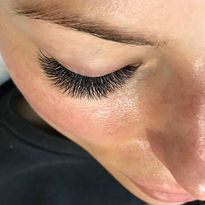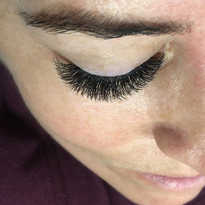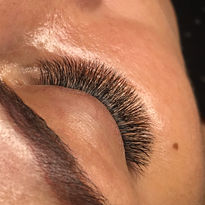
Eyelash Extensions
Typical length of artificial eyelashes is from 4 to 18 mm. Different lengths can be used depending on the place of eyelash staging.
The maximum allowable length of an artificial eyelash is considered to be + 30% of the natural length. For a natural length (or slightly longer) we choose eyelashes 1, 2 mm longer than original.
The thickness of the eyelashes comes in 4 types. The thinnest are silk (0.03-0.07 mm), then mink (0.10 mm), sable (0.12-0.15 mm) and plastic (0.18-0.3 mm).
Artificial eyelashes are also distinguished by their curvature :J, B, C, C+, D, D+, L, L+, M, LD, LC, V
The curl is selected according to the type of eye. Experienced eyelash technicians often mix different types of curvatures in their work for modelling the look.
All prices shown are VAT inclusive
The Fascinating History of Eyelash Extensions: From Hollywood Glamour to Everyday Beauty
Eyelash extensions might feel like a modern beauty obsession, but did you know their roots trace back over a century? What began as a theatrical accessory has blossomed into a must-have beauty service around the world. Let’s take a journey through time and uncover the surprising evolution of eyelash extensions.
1911: The First False Lash Patent
Our story begins in 1911, when Canadian inventor Anna Taylor patented a unique design for artificial eyelashes. These early falsies were made using human hair woven onto a tiny strip of fabric and glued to the eyelid. Not exactly the seamless lash lift we’re used to today — but it was the start of something magical.
1916: Lashes Hit the Big Screen
Just a few years later, Hollywood director D.W. Griffith wanted his lead actress, Seena Owen, to have lashes “that brushed her cheeks” in the silent film Intolerance. A wig maker crafted lash extensions from human hair, applying them with spirit gum. It was a bold move that made lashes a cinematic sensation.
1930s–1950s: From Film to Fashion
With the glitz and glamour of old Hollywood, false eyelashes became a red carpet staple. Actresses like Marilyn Monroe and Rita Hayworth made fluttery lashes part of their signature looks. By the 1950s, synthetic strip lashes were widely available in beauty salons and even sold in department stores.
1960s–1980s: The Mod Lash Movement
Enter the swinging ‘60s: an era of bold fashion, dramatic makeup, and iconic eyes. Model Twiggy made lower lash accents and thick upper lashes a trend, turning falsies into a statement piece. Strip lashes reigned supreme during this period, embraced by makeup lovers everywhere.
Early 2000s: The Modern Lash Extension Is Born
While strip lashes had their moment, the next big leap came from Japan and South Korea in the early 2000s. Beauty professionals began attaching individual synthetic fibers to natural lashes, creating a semi-permanent, natural-looking enhancement. These were the true lash extensions we know today — no more glue-on strips, just soft, fluttery fullness that lasted for weeks.
2010s–Now: Lash Artistry Takes Over
Lash extensions quickly became a global beauty phenomenon. Today, clients can choose from a wide range of styles — classic, volume, hybrid, even mega volume — tailored to their eye shape and preferences. Materials have also evolved, with options like faux mink, silk, and cashmere offering various levels of softness and drama.
The artistry behind eyelash extensions has become highly specialized, with certified lash technicians using mapping techniques, advanced adhesives, and meticulous application methods to deliver flawless results.
From Vintage to Vogue
What started as a Hollywood experiment is now a global industry — and it’s not slowing down. Eyelash extensions have empowered people to express their style, boost their confidence, and wake up feeling effortlessly polished.
Whether you’re a lash lover or just lash-curious, it’s fascinating to see how far we’ve come — one lash at a time.
































